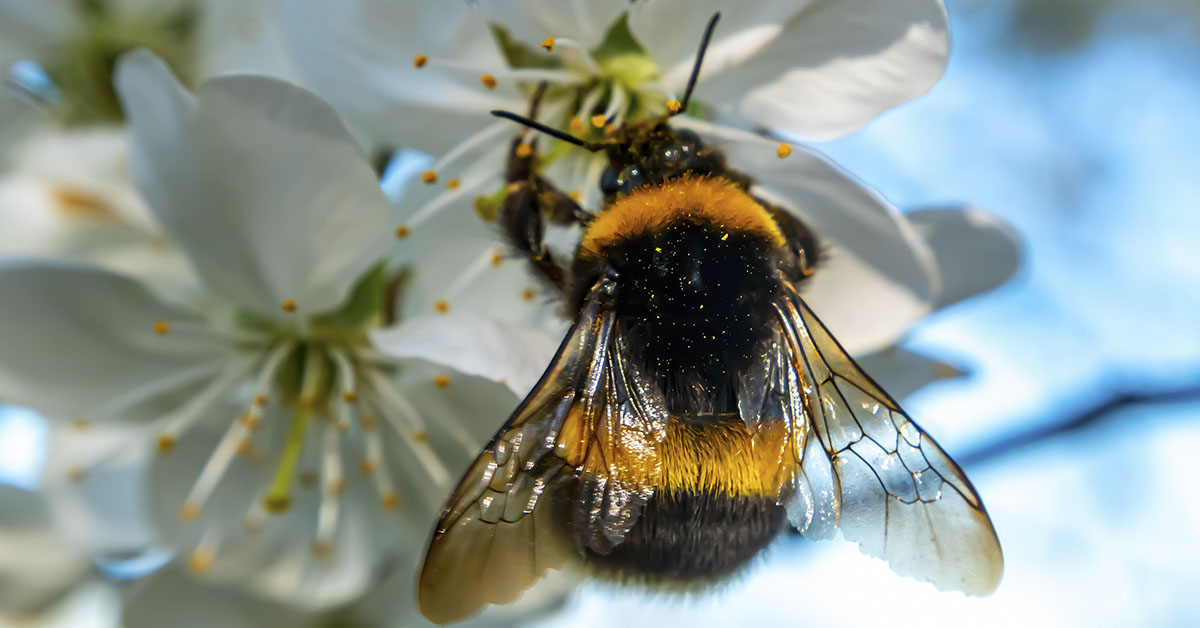A new study has observed a fascinating behavior in bumblebees: They play, possibly just for fun. This may be the first documented proof of insects playing. And if bumblebees enjoy recreational activities — in this case, rolling wooden balls — what else are they capable of? This study may indicate that insects have a deeper inner life than once thought. They may even be capable of experiencing emotions.
Playful Bumblebees
Samadi Galpayage, a Ph.D. student at Queen Mary University of London, and her team were inspired by a report from 2017, where bumblebees were trained to roll balls into nets to attain food rewards. [1] But Galpayage and her colleagues had a new question: Could bees play with the balls for the sake of fun?
In the study, the team released 45 buff-tailed bumblebees of varying ages into an arena with only one entrance. Through it, the bees could reach pollen and sugar water but they had to fly through two rooms, one with loose, wooden balls, and one with balls glued to the ground. Throughout the 18 sessions, three hours each, the room with the loose balls was 50% more occupied than the one with the stationed balls. Although rolling the balls served no clear purpose, every bee voluntarily rolled the ball between once and 117 times.
This action meets all five criteria of play, which involves an activity that isn’t immediately functional but is voluntary, spontaneous, and inherently rewarding. The activity also is different from other adaptive behaviors, and although the process is repeated, it changes. Plus, it happens in a stress-free environment.
The team then trained 42 new bees to associate the rolling balls with a colored room. Later, they gave the bumblebees an option of two empty rooms of different colors. Even though the bees couldn’t see what was in the chambers, more bees picked the color they had associated with the balls. Bear in mind, this decision was not based on picking an area to find food or mating; it was based on the preference for play. [2]
Read: Why You Should Never Ever Kill A House Centipede If You Find One Inside Of Your Home
“Insect minds are far more sophisticated than we might imagine”
“When you look at the videos of the bees on the balls, if you saw that in a dog, or a monkey, or even a bird, we’d have no problem calling it play,” says Gordon Burghardt at the University of Tennessee, Knoxville, who was not involved in the study. [3] And like with other species, some individual bees acted more playful than others. For instance, younger bees rolled more balls than older bees. Plus, male ones rolled for longer periods of time than the females in the same age bracket. Galpayage suggests the mental physical exercise involved with play may be beneficial for young bumblebees, as it would benefit kittens and puppies as they learn hunting skills.
“This research provides a strong indication that insect minds are far more sophisticated than we might imagine,” said Lars Chittka, a professor of sensory and behavioral ecology at Queen Mary University of London, who led the study, in a statement. “We are producing ever-increasing amounts of evidence backing up the need to do all we can to protect insects that are a million miles from the mindless, unfeeling creatures they are traditionally believed to be.” The study concludes with the hope that future research would explore the possible advantage of playing behaviors and how they might benefit bees’ early brain development. [4]
Can Bumblebees Feel Emotions?
However, if bees exhibit this behavior with balls in a controlled environment, there’s more to learn about how they might “play” in the wild. Beekeeper Shelley Hoover, a biological sciences researcher at Alberta’s University of Lethbridge, suggests that play may be linked to the survival chore of foraging. “Bees, particularly bumblebees, forage on diverse and complex flowers, and so need to be able to solve these flower puzzles to access the nectar rewards the flowers offer,” she said. “Learning is a very important part of being a good forager, and play is often associated with learning.” Therefore, this study demonstrates bees’ intelligence, since they use learning and problem-solving techniques to find food and survive. [5]
Despite this promising study, more evidence is needed to prove insects experience feelings. “They may actually experience some kind of positive emotional states, even if rudimentary, like other larger fluffy, or not so fluffy, animals do,” Galpayage said in a statement. “This sort of finding has implications to our understanding of sentience and welfare of insects and will, hopefully, encourage us to respect and protect life on Earth ever more.” [6]
Keep Reading: Swarming bees stir up their own electric fields
Sources
- “Bumblebees show cognitive flexibility by improving on an observed complex behavior.” Science. Olli J. Loukola. February 24, 2017.
- “We Have The First Evidence of Bumble Bees Playing With Toys, And It’s Utterly Adorable.” Science Alert. Tessa Koumoundouros. November 7, 2022
- “Bumblebees rolling wooden balls may be first evidence of insect play.” New Scientist. Corryn Wetzel. November 2, 2022
- “Do bumble bees play?” Animal Behavior. Hiruni Samadi Galpayage Dona. October 19, 2022
- “Bumblebees play with balls just for fun, study finds.” CBC. Sheena Goodyear. November 3, 2022
- “If bumblebees can play, does it mean they have feelings? This study suggests yes.” NPR. Vanessa Romo. November 5, 2022.

